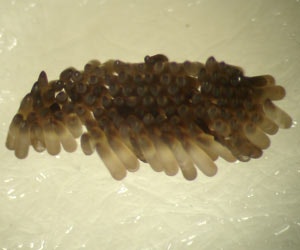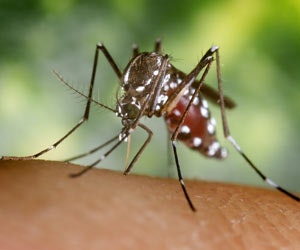Mosquito Biology
In the mosquito lifecycle, there are four separate and distinct stages: Egg, Larval, Pupal and Adult. This is known as a complete metamorphosis and each stage can be easily recognized by its unique appearance.
Egg:

Mosquitoes deposit eggs in varying ways. Some species will lay eggs directly on the surface of water; either singly or in 'rafts' consisting of many eggs stuck together. These eggs float on the water's surface until they hatch. Other species lay their eggs one by one, in damp soil or on the sides of containers, in the expectation that water levels will rise, submerse the egg and allow them to hatch. Some species have eggs that can lie dormant (not submersed in water) for many years until they are finally covered with water and then they will hatch. It is important to remember that at least 4 days of relatively calm water is a necessity in the mosquito lifecycle. If this pattern is broken or not allowed to happen in the first place, then mosquitoes will not develop.
Larva:

Larvae (plural of larva) live in the water but are required to 'break' the water's surface to breathe. Most species have specialized breathing siphons at the 'tail' end of their bodies. Anopheles (a genus of mosquito) larvae have breathing openings along its back, and Coquillettidia perturbans attach to aquatic plants and breathe through the plants stalks. However, most species of larvae hang, upside down, breathing and filtering food with their specialized mouthparts. During the growth process, larvae will molt 4 times. Each molt is known as an instar. After the 4th Instar, a larva will change into a pupa.
Pupa:

Pupae (plural of pupa) also live in the water. Instead of a single siphon tube for breathing (like most larvae) pupae have two siphon tubes, that are now located on the back of the "head" of the pupa. These are known as 'trumpets.' Pupae do not eat or go through a molting process; they only breathe air and change inside their casing. Once the metamorphosis is complete, a pupa will go to the surface of the water, the back of it’s casing will split and an adult mosquito will emerge.
Adult:

After breaking free of the pupal skin, the adult will rest on the water's surface for a brief period of time to allow its body and wings to dry and harden. Once this has occurred the adult mosquito can now fly. There are over 2,500 different species of mosquitoes in the world and about 16 different species within Benton County Mosquito Control District. Different species will have different characteristics and behaviors. This affects things like; active time period (e.g., daytime or nighttime biters), how far they fly from their hatching source, what types of animals they "prefer" to bite (Example; some prefer birds over mammals) and other factors.
Summary:
Mosquitoes can be quite diverse but there are some common characteristics that allow control methods to work. Most importantly, they all require, at a minimum, 4 days of relatively calm water (with at least some organic matter present) to develop and hatch off. Impacting these areas can reduce available growth sites and the number of mosquitoes present.
